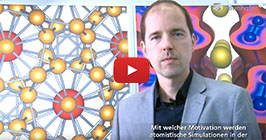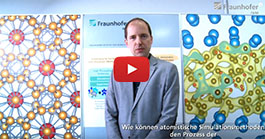Materials Modeling
We investigate material behaviors and predict material properties using theoretical and computational methods based on solid-state physics and materials mechanics. Our ambition is to design material structures with targeted properties and functions. We identify the effects of crystalline defects and microstructures on the material behavior, and we explore means to avoid negative or exploit positive effects.
What we offer
Using simulator-based methods based on theoretical solid-state physics and materials mechanics, we can resolve material behavior and predict material properties.
- Elucidation of the inner mechanisms of materials and identification of cause-effect relationships
- Calculation of material properties and prediction of material behaviour
- Investigation and evaluation of new types of functional materials and materials
- Development of physical models to describe materials in their complex context of use or production
We resolve the correlation between the physical properties of a material on the one hand and its atomic and electronic structures on the other. We provide understanding of the underlying mechanisms and relationships, and this enables you to optimize the starting materials of your products and thus to adapt them to specific operating conditions and requirements:
- Structural properties such as atomic crystal structure and chemical composition
- Thermodynamic properties such as energy of formation and phase stability
- Mechanical properties such as elastic constants and mechanical tensions
- Electrical properties such as electrical conductivity, band structure and dielectric constants
- Piezoelectricity
- Magnetic properties such as magnetization and anisotrophy
- Optical properties such as transparency and reflectivity
- Thermal properties such as the coefficient of thermal expansion
- Kinetic properties such as energy barriers for nuclear diffusion processes
Contact us! Together we'll find a customized solution for the challenges you face.
The fields of application in which our expertise of physical materials modeling can make a significant contribution are:
- Development and use of complex functional materials.
- Products in which material combinations and the interaction of materials decide the function.
- Functional components for where the most extreme demands are made regarding the reliability and function of materials and components and on error rates in production.
- Development and improvement of materials where trial-and-error loops are uneconomic and do not lead to a solution, and where a fundamental understanding of the problem is required.
For example in lighting technology, in steel or ceramics manufacture, in photovoltaics or in electromagnetic generators and motors, in energy storage and energy conversion systems.
Topics for collaboration
Unwanted or unintended changes in the properties or function of the material manufactured or used (e.g. failure or breakdown of protective layers, interface reactions in layer sequences, the formation of mixed phases)
- We investigate the causes of failure in materials due to microstructural changes. This allows the manufacturing process to be designed such that the optimum microstructure is obtained and the strength and working life of the material is improved. Separations and structural defects in iron and steel.
- Prediction of the influence of additives on functional properties. Ferro-electric ceramic materials for piezo applications.
- Understanding of the optical and electronic properties of semiconductor materials through band-structure engineering. Optically transparent, electronically conductive oxides.
Improvement to materials (e.g. protection against corrosion and damage from hydrogen)
- We investigate and model diffusion processes for an understanding of corrosion and embrittlement. The knowledge gained is used to develop effective protective layers and to achieve an extended material service life. Hydrogen in iron and steel.
New development of materials and substitution of materials (e.g. magnet, battery and piezo materials)
- We investigate the behavior of individual atoms in your material-specific environment, such as lithium ions in battery substances, for example. NZP materials as a solid-state electrolyte for lithium-ion batteries.
- We develop efficient, rapid methods of finding replacements for critical elements such as costly raw materials or additives that are harmful to health, or for reducing the amount of such elements that are in use. New hard magnets without rare earth metals.
- Multiscale modeling for the virtual development of polycrystalline materials; reliability and long life of carbide, nitride and oxide ceramics.
Development of materials models for:
- Deformation (elasticity, plasticity and breakage)
- Damage (diffusion, reaction, corrosion)
- Conductivity (electron conductivity, ion conductivity)
- Piezoelectricity
- Magnetism
- Optical transparency
- Impurities
- Crystal defects
- Separations
- Functionality of metals, semiconductors and ceramics
We define the scope of services required jointly with our clients
Calculation of Properties: We calculate the material properties of an existing system (system to be defined) in order to obtain a model representation of its functions (e.g. layer adhesion, plasticity, elasticity, phase stability)
Optimization Concepts: We simulate structure-to-property relationships and derive knowledge-based measures on how to move from the initial status to a target status. Under which conditions do which effects occur?
Development Projects: We develop new materials or material combinations together with our partners
The forms of collaboration are determined by the client’s needs and the demands of the task and range from consultation meetings, workshops and feasibility studies through to direct contract or consortium-based R&D projects.
The process of a project
Step 1: client input: description of task
- Materials used
- Manufacturing process
- Process conditions
- The problem encountered
Step 2: analytical problem diagnosis
- Delimit the potential material mechanisms or phenomena
- Formulate potential cause-effect relationships
- Prioritize cause-effect relationships
- Define necessary or additional experimental and theoretical investigations
- Derive efficient strategies for solving the problem
Step 3: check the problem-solving strategy
- Conduct experiments and simulations.
- Examine cause-effect relationships on the basis of prototype parameter variations in the material development or in the manufacturing steps of the client.
- Validate relationships of source materials and manufacturing steps with material properties and functions.
Step 4: implementation of the solution in the company
 Fraunhofer Institute for Mechanics of Materials IWM
Fraunhofer Institute for Mechanics of Materials IWM

